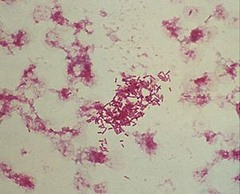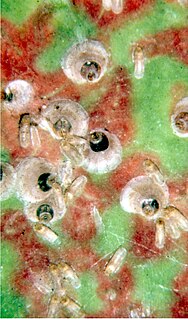Related Research Articles

Aspidiotus is a genus of armoured scale insects. It includes several agricultural and horticultural pests.

Diaspididae is the largest family of scale insects with over 2650 described species in around 400 genera. As with all scale insects, the female produces a waxy protective scale beneath which it feeds on its host plant. Diaspidid scales are far more substantial than those of most other families, incorporating the exuviae from the first two nymphal instars and sometimes faecal matter and fragments of the host plant. These can be complex and extremely waterproof structures rather resembling a suit of armor. For this reason these insects are commonly referred to as armored scale insects. As it is so robust and firmly attached to the host plant, the scale often persists long after the insect has died.

Morganella morganii is a species of Gram-negative bacteria. It has a commensal relationship within the intestinal tracts of humans, mammals, and reptiles as normal flora. Although M. morganii has a wide distribution, it is considered an uncommon cause of community-acquired infection and it is most often encountered in postoperative and other nosocomial infections such as urinary tract infections.
Kuwanaspis is a genus of scale insects belonging to the family Diaspididae. They feed on bamboo.

Nassaria is a genus of sea snails, marine gastropod mollusks in the family Nassariidae.
Morganella is a genus of puffball fungi in the family Agaricaceae. The genus name honors American botanist Andrew Price Morgan (1836–1907). The widely distributed genus is prevalent in tropical areas. A 2008 estimate placed nine species in Morganella, but several new species have since been described.

Aulacaspis, is a scale insect genus in the family Diaspididae. The type species is Aulacaspis rosae.

Parlatoriini is a tribe of armored scale insects. Takagi (2002) indicated that the Parlatoriini appear to be phylogenetically related to the Smilacicola and the Odonaspidini. Takagi went on to say about the tropical east Asian Parlatoriini that, The current classification of their genera may be largely tentative because the adult females are simple-featured and much modified owing to the pupillarial mode of life, and also because the second instar nymphs are generally similar among parlatoriines, whether the adult females are pupillarial or not. Andersen found that separating out pupillarial forms into a separate subtribe, Gymnaspidina, was counterproductive, as being non-dispositive.
Augulaspidina is a subtribe of armored scale insects. It was not confirmed by Takagi's 2002 study.

Chionaspidina is a subtribe of armored scale insects established by Borchenius. But unlike many of the subtribes recognized by Borchenius, this one was found to be morphologically valid by Takagi. Similarly, in molecular analysis, Andersen et al. found a clade roughly corresponding to the subtribe Chionaspidina.
Diaspidina is a subtribe of armored scale insects. It occurs mostly in the Americas and Africa, with a few species in tropical Asia. In the Americas Pseudoparlatoria is the largest genus, with Diaspis second; in Africa Diaspis is the largest genus. The grouping identified by Balachowsky in 1954 as the subtribe Diaspidina, are now the tribe Diaspidini.
Kuwanaspidina is a subtribe of armored scale insects. They feed on bamboo.
Rugaspidiotina is an obsolete subtribe of armored scale insects. It was established by Balachowsky in 1949 to accept those Diaspidinae which had rugaspidiotine characteristics as exemplified by genus Rugaspidiotus MacGillivray, species Rugaspidiotus arizonicus, and was moved from the Odonaspidini to the Diaspidini by Borchsenius. It was raised to tribe status as Rugaspidiotini. However, close examination of species assigned to the Rugaspidiotini showed that the rugaspidiotine characteristics convergently evolved in different groups of diaspidids. Rugaspidiotini and Rugaspidiotina are now regarded as obsolete groupings.
Sclopetaspidina is a subtribe of armored scale insects. It was not confirmed by Takagi's 2002 study.
Chionaspis is a genus of scale insect. In 2011 geographical sampling and analysis indicated a number of unnamed species in the genus Chionaspis.
Sadao Takagi is a Japanese entomologist who has specialised in the scale insects (Coccoidea), particularly the armoured scale insects of the Diaspididae.

Leucospermum praemorsum is an evergreen shrub or small tree of up to 5 m (16 ft) high. It has hairless oblong to inverted lance-shaped leaves of 7–8 cm long and 1½–2 cm wide, tapering at their base to a stalk of up to 2 cm long, and cut-off at the tip with three to five teeth, and pale carmine, inverted cone-shaped flower heads. From the center of the flowers emerge long initially orange, later deep crimson styles that jointly give the impression of a pincushion. It is called Nardouw fountain-pincushion or Nardouw pincushion in English and Nardouwluisiesbos in Afrikaans. Flower heads can be found off and on throughout the year, particularly in older plants, with a peak between July and December. It is an endemic species that can only be found in part of the Western Cape province of South Africa.

Parlatoria is a genus of scales and mealybugs in the family Diaspididae. There are at least 60 described species in Parlatoria.

The Morganellaceae are a family of Gram-negative bacteria that include some important human pathogens formerly classified as Enterobacteriaceae. This family is a member of the order Enterobacterales in the class Gammaproteobacteria of the phylum Proteobacteria. Genera in this family include the type genus Morganella, along with Arsenophonus, Cosenzaea, Moellerella, Photorhabdus, Proteus, Providencia and Xenorhabdus.
Selenaspidus articulatus is an armoured scale insect in the family Diaspididae, commonly known as the West Indian red scale. It is a polyphagous species found in tropical and subtropical regions around the world as a pest species of Citrus and other fruit and ornamental trees.
References
- Takagi, Sadao (2007). "A revised concept of Morganella, with other forms (Homoptera: Coccoidea: Diaspididae)" (PDF). Insecta Matsumurana. Series Entomology. New Series. 63: 51–65. Archived (PDF) from the original on 28 December 2013.